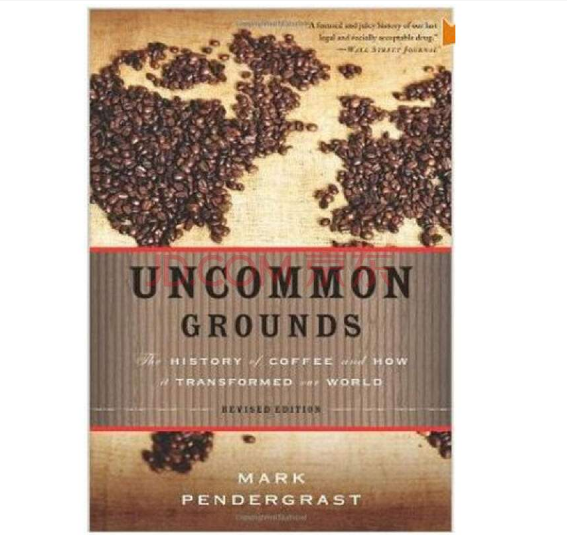Coffee book recommendation: left-handed coffee, right-handed world "Uncommon Grounds"
Original title: Uncommon Grounds: the history of coffee and how it transformed the world
Left-handed Coffee, right-handed World
Publishing house: machinery industry
The book "Uncommon Grounds" entered the field of vision a few years ago, but at first it could not be found through all the traditional channels, but at last I finally got the original edition, and before I made up my mind to reclaim it, I was surprised to find that the mechanic had already published the Chinese version, but after translation, the name was much different-left-handed coffee, right-handed world.
To be honest, just looking at such literary and artistic names, there is some curiosity to know the content, just like seeing a beautiful woman, I can't help but want to kiss Fangze, O (∩ _ ∩) Orange, joking. However, in other words, I wonder how the translator (or lady) came up with such an elegant translation, and it would be difficult to connect the two if he hadn't mentioned the original name of Uncommon Grounds in the introduction, not to mention that the covers of the books had been changed.
Although the Chinese translation of the title is eye-catching, compared with the original, the title of the original book is more plain, a good summary of the content of the book, the history of coffee and how it transformed the world, the history of coffee and how coffee changed the world. For some friends who only read the title of the book and buy the book, the Chinese translation of the title is easy to mislead.
Talk less and talk about the content.
The content can be rich, and it is not as full of pictures and texts as many books in China-forgive someone for changing the topic again and talking about the matter of both pictures and texts. Originally, the word "both pictures and texts" is often used as a commendatory context, but now, some books are really speechless, and "dazzling" is even more true.
Back to the point, content.
Books are classified into business history categories, and the whole can be seen as the history of the coffee industry in the United States, involving the coffee industry of other countries, including producing countries and other consumer countries.
The book focuses on a chronicle of the coffee industry in the United States, but the author has a broad vision, taking into account the background of the coffee industry around the world, such as the discovery of coffee, coffee producing areas such as Brazil. Much of the content in the book is a good supplement to existing coffee books. For example, when it comes to the economy of coffee producing areas, many books have actually talked about the ups and downs of Brazilian coffee prices, but this book (Uncommon Grounds) is the first to record the situation of Brazilian coffee in detail. Including a more detailed description of the market price fluctuations of raw coffee beans in the book, the various responses made by the Brazilian government and industry, and reminiscent of various reports that the price of raw coffee beans in Yunnan fell below the cost line this year, although nearly a century has passed, it still makes a lot of sense.
The book describes in detail the rise of coffee in the United States, as the world's largest coffee consumer, how to achieve this status of coffee, after reading this book can find a clearer answer.
The book tells the history of the development of the American coffee industry, from the instant coffee that the public is most familiar with, to the trend of boutique coffee, which is still partially confined to the niche market (as for the question of whether fine coffee is a minority, someone will "discuss" it alone, those who dislike it, please skim by automatically, O (∩ _ ∩) O Thank you), all have a place in the book.
Originally, as a boutique coffee practitioner, someone hoped to see more information about "boutique coffee" from abroad, but he actually made up a lesson in the history of coffee in the United States. Of course, the books are full of content, and the author's writing is also very interesting. Occasionally, there are times when people feel the same way. Of course, this immersive reading experience is also inseparable from the work of the translator. As a translation of well-known foreign language books, the translation of this article can hit four stars, although there are some mistakes, but from the translation of many coffee terms, we can see that the translator has indeed done his homework, there is no nonsense, quite responsible.
This book is suitable for people:
1. Friends who are interested in history books and don't mind reading long texts. Roughly 400 pages, full of text, 300000 words is there.
two。 An appellant who decorates bookshelves and fills the facade. The layout of this book is quite stylish, with a deep and profound style. Not to mention the title of the book is, uh, stylish? Put a book in a coffee shop or somewhere where you pretend to be inconspicuous, so that the owner will definitely be equipped with intellectual style.
3. Friends who like coffee and want to know the history of coffee culture.
Reading Tips:
This book is a book with a cultural and historical background, although it also mentions the trend of boutique coffee and its development in the United States, and the author's tone also reveals the pursuit of coffee quality and the recognition of high-quality coffee, but it should be noted that the center of this book is coffee, boutique coffee is an ongoing stage in the process of development.
This book has nothing to do with coffee technology. Please pay attention to this book.
This book can enrich the cultural self-cultivation of readers, as for pragmatic readers, please note that there is no recipe in it, do not buy the wrong book, and then randomly give bad reviews of "bad books".
Someone commented: four stars
The original reputation of this book: this book is mentioned in many high-quality coffee books references; many well-known coffee websites or coffee people have also made recommendations.
Chinese version and original cover:


Important Notice :
前街咖啡 FrontStreet Coffee has moved to new addredd:
FrontStreet Coffee Address: 315,Donghua East Road,GuangZhou
Tel:020 38364473
- Prev

Can you get "drunk" even if you drink coffee? People with two kinds of physique are not suitable to drink!
Does ▲ get "drunk" when he drinks coffee? People with two kinds of physique are not suitable to drink. Can you get drunk even if you drink coffee? In the concept of traditional Chinese medicine, coffee is an irritating drink, which can easily cause damp-heat constitution. Lai Ruixin, a traditional Chinese medicine practitioner, pointed out that some people are uncomfortable when drinking coffee, also known as "coffee drunkenness." in fact, it is coffee poisoning or caffeine sensitivity, easy to be sensitive to coffee is a physical problem, spleen and stomach damp-heat physique.
- Next

Coffee book recommendation: picture book "Coffee:from bean to the perfect br"
A lovely little book for coffee lovers from Melbourne, Australia. The volume is very small, whether it is physical volume or text content. At first glance, I didn't think it was a picture book. I just thought it was a lively design. When I turn to the first page, I can't help thinking of the lovely and overeaten book "making a good Cup of Coffee". I can't help poking it in my heart and making a comparison.
Related
- Beginners will see the "Coffee pull flower" guide!
- What is the difference between ice blog purified milk and ordinary milk coffee?
- Why is the Philippines the largest producer of crops in Liberia?
- For coffee extraction, should the fine powder be retained?
- How does extracted espresso fill pressed powder? How much strength does it take to press the powder?
- How to make jasmine cold extract coffee? Is the jasmine + latte good?
- Will this little toy really make the coffee taste better? How does Lily Drip affect coffee extraction?
- Will the action of slapping the filter cup also affect coffee extraction?
- What's the difference between powder-to-water ratio and powder-to-liquid ratio?
- What is the Ethiopian local species? What does it have to do with Heirloom native species?

